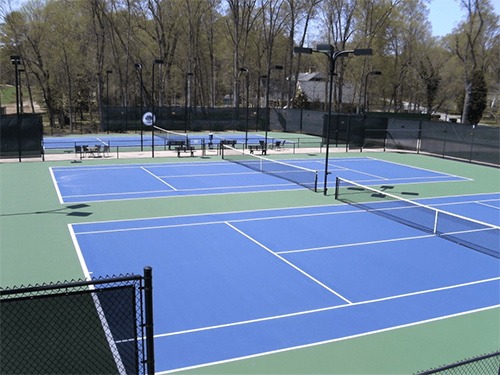A well-maintained tennis court is the foundation of a successful tennis program. To maintain this foundation, many surfaces need to be resurfaced or replaced periodically. Fortunately for most courts, resurfacing is much cheaper than replacing the surface entirely. The age and use of your facility will determine if it needs resurfacing or replacement.
What Factors Should I Consider for Resurfacing My Tennis Court
Age of the Court: The age of your tennis court will determine if resurfacing is necessary. If you regularly play on the surface, it’s recommended that you reseal your floor every two years. This will keep your playing surface smooth even while preventing cracking and peeling. If you don’t play regularly or not at all, then resealing isn’t necessary for several more years.
Court Use: While many people believe that there’s no difference between how frequently a court should be resurfaced based on use, this isn’t always true. If players are regularly running around on your courts or there are shoes worn down onto the asphalt, then frequent resurfacing is needed to maintain quality. Alternatively, if very little play occurs on your courts, you may be able to go a few years before having them resurface.
Surface Condition: How often you have your court resurfaced is based upon the traits of the specific surface that’s been used. The regularity with which you need to resurface will depend upon how well it was installed and taken care of initially. In addition, if there are any unusual factors such as poor drainage or extreme temperature changes where your court is located these can also affect the way in which it wears over time.
When to Resurface, Repair, or Replace Your Court
Usually, courts that are under 8 years old need resurfacing. As you play on your court, the surface layer of rubber is able to absorb most of the shock from running and jumping. When the impact becomes too much for this surface layer to handle, it begins to crack or crumble away. The process can be accelerated by sub-par care practices such as overwatering or using cleaners that contain harsh chemicals.
The best time to resurface a court is when it reaches about 75-80% of its lifespan. If you wait longer than this, it may be difficult and costly to restore the court’s shock-absorbing properties and smoothness.

What Materials Should Be Used When Resurfacing a Tennis Court
Acrylic Resurfacer is a liquid substance that’s used to prepare new surfaces and color the surface of asphalt tennis court surfaces when they’re being restored. This product contains 100 percent acrylic latex binders.
It may be used to repair cracked and damaged tennis court surfaces once it has been exposed to silica sand. The quality of the resurfacer solution is dependent on the type of sand utilized. Quality sand must not contain clay or salt, which can inadvertently cause stains or damage the finish of your floor. It’s also crucial to avoid over-dilution. If you use a good combination, it will ensure that no more than two-fifths of the Acrylic resurfacer is diluted with water. Over-dilution causes streaking, failure of the coating’s adhesion, and a coating’s low longevity.
The Importance of Quality Resurfacing
There are two options to choose from when considering resurfacing: hot or cold. Cold resin application is less expensive; however, the process is only as good as the skill of those performing it due to inconsistent results. Hot-mix surfaces take longer to apply but cure to a much smoother texture with better ball bounce quality (duration and height). Contractors need special equipment and materials for this type of repair that can factor into the cost, but these courts usually last for an average of 15 years.
Is Resurfacing Or Replacing Your Tennis Court Best?
A resurfaced tennis court will be much smoother than it was before, which will allow players to play on their shots with greater ease. Resurfacing also ensures that your facility is safe for the athletes who use it. When asphalt gets too thin to hold pebbles in place, it becomes dangerous during normal use. A thin asphalt surface can compromise the traction and even the safety of players at times.
When you decide to have your surface resurfaced, a new layer of oil-based asphalt along with an acrylic coating is applied over the top of the old material. Asphalt has long been used for this application because its porous nature allows the newer materials to grip tightly onto each other without the use of any adhesive.
This combination tends to provide a safer and smoother playing surface for your athletes than asphalt on its own or if the existing asphalt is too severely damaged. This means that it’s more likely to improve court safety and playability than replacing your whole tennis court would be able to do.
Get In Touch With Our Team for The Best Tennis Court Resurfacing
Resurfacing is the cheaper option for restoring your tennis court. If you can afford it, however, it’s best to choose a hot-mix resurfacing. This process yields the best results and gives you a smooth surface with a good bounce (duration and height). If you decide on this method, plan for at least 9 days where the court is closed due to application and curing time. Call our team at (919) 365-7500 for more information, starting today.
